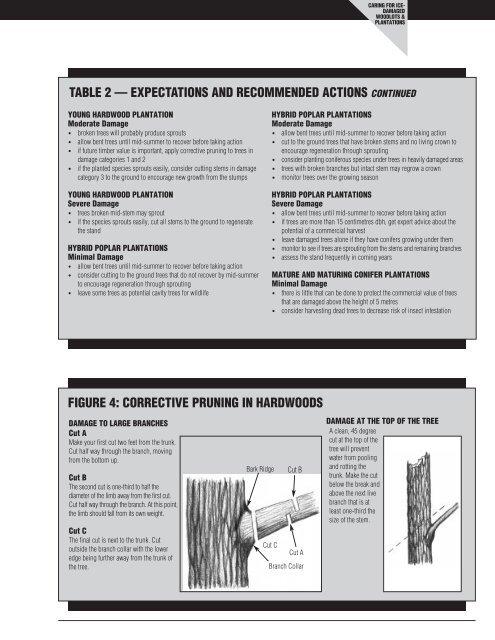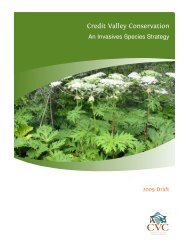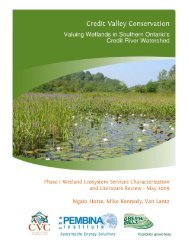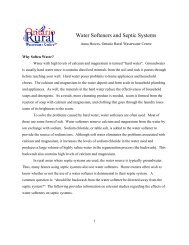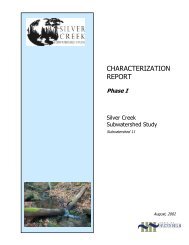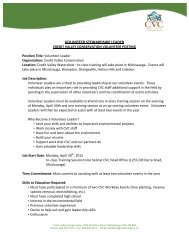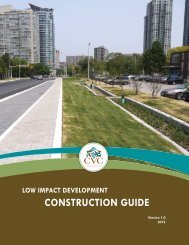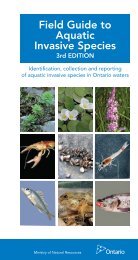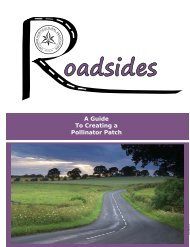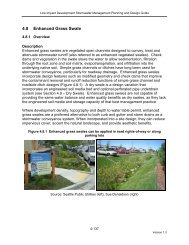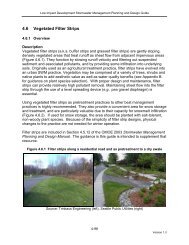caring for ice-damaged woodlots and plantations - LandOwner ...
caring for ice-damaged woodlots and plantations - LandOwner ...
caring for ice-damaged woodlots and plantations - LandOwner ...
You also want an ePaper? Increase the reach of your titles
YUMPU automatically turns print PDFs into web optimized ePapers that Google loves.
CARING FOR ICE-DAMAGEDWOODLOTS &PLANTATIONSTABLE 2 — EXPECTATIONS AND RECOMMENDED ACTIONS CONTINUEDYOUNG HARDWOOD PLANTATIONModerate Damage• broken trees will probably produce sprouts• allow bent trees until mid-summer to recover be<strong>for</strong>e taking action• if future timber value is important, apply corrective pruning to trees indamage categories 1 <strong>and</strong> 2• if the planted species sprouts easily, consider cutting stems in damagecategory 3 to the ground to encourage new growth from the stumpsYOUNG HARDWOOD PLANTATIONSevere Damage• trees broken mid-stem may sprout• if the species sprouts easily, cut all stems to the ground to regeneratethe st<strong>and</strong>HYBRID POPLAR PLANTATIONSMinimal Damage• allow bent trees until mid-summer to recover be<strong>for</strong>e taking action• consider cutting to the ground trees that do not recover by mid-summerto encourage regeneration through sprouting• leave some trees as potential cavity trees <strong>for</strong> wildlifeHYBRID POPLAR PLANTATIONSModerate Damage• allow bent trees until mid-summer to recover be<strong>for</strong>e taking action• cut to the ground trees that have broken stems <strong>and</strong> no living crown toencourage regeneration through sprouting• consider planting coniferous species under trees in heavily <strong>damaged</strong> areas• trees with broken branches but intact stem may regrow a crown• monitor trees over the growing seasonHYBRID POPLAR PLANTATIONSSevere Damage• allow bent trees until mid-summer to recover be<strong>for</strong>e taking action• if trees are more than 15 centimetres dbh, get expert adv<strong>ice</strong> about thepotential of a commercial harvest• leave <strong>damaged</strong> trees alone if they have conifers growing under them• monitor to see if trees are sprouting from the stems <strong>and</strong> remaining branches• assess the st<strong>and</strong> frequently in coming yearsMATURE AND MATURING CONIFER PLANTATIONSMinimal Damage• there is little that can be done to protect the commercial value of treesthat are <strong>damaged</strong> above the height of 5 metres• consider harvesting dead trees to decrease risk of insect infestationFIGURE 4: CORRECTIVE PRUNING IN HARDWOODSDAMAGE TO LARGE BRANCHESCut AMake your first cut two feet from the trunk.Cut half way through the branch, movingfrom the bottom up.Cut BThe second cut is one-third to half thediameter of the limb away from the first cut.Cut half way through the branch. At this point,the limb should fall from its own weight.Cut CThe final cut is next to the trunk. Cutoutside the branch collar with the loweredge being further away from the trunk ofthe tree.Bark RidgeCut CCut BCut ABranch CollarDAMAGE AT THE TOP OF THE TREEA clean, 45 degreecut at the top of thetree will preventwater from pooling<strong>and</strong> rotting thetrunk. Make the cutbelow the break <strong>and</strong>above the next livebranch that is atleast one-third thesize of the stem.


